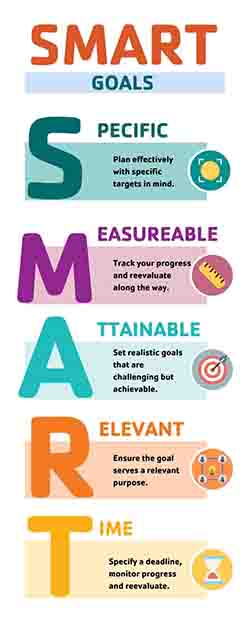
It’s 2023 – making the change to a healthy lifestyle can be simple with SMART goals!
A successful program starts with completing one achievable goal at a time for sustainable progress. Goal setting is a highly effective tool to help create change, cause action, and provide adherence to a goal. When starting a fitness and wellness lifestyle change, you need to start with an idea of your goals and create a plan for how you will attain your desired outcome. Understanding your goals is essential for motivation and self-discipline to keep taking the necessary steps to achieve your goals. SMART goals are a great way to break down and understand your fitness and wellness journey to help you reach your ultimate goal. Understanding a SMART goal is the first step to creating a goal that works best for you!

- Specific goals are plans with particular targets in mind for you to achieve. For example, there is a goal to improve cardiovascular fitness, which is a broad goal and can be overwhelming not knowing where to start. Making it more specific helps it become more achievable and provides a starting point to begin. For example, instead of using the general goal of improving cardiovascular fitness, we can change it to run a 5k (3.1 miles) underneath 30 minutes which is specific and provides motivation to achieve the goal.
- Measurable goals are essential to track your progress and allow a reevaluation along the way to reaching your goal. For example, if the goal is to improve cardiovascular fitness, run a 5k to reach your goal. In addition, you can measure progress by running 3.1 miles periodically to track how close you are to achieving a time underneath 30 minutes.
- Attainable is setting realistic goals that are challenging but achievable. Setting realistic expectations of your fitness journey is a great way to keep you motivated and help you reach your overall fitness and wellness goal. For example, following a cardiovascular running program prior to the new goal that has you running a 5k (3.1 miles) underneath 35 minutes makes it more attainable to run that same distance underneath 30 minutes with a conditioned body to running.
- Relevant ensures that the goal serves an appropriate purpose and improves your fitness and wellness. The specific objective is to run a 5k (3.1 miles) underneath 30 minutes, enhancing and challenging cardiovascular fitness. We started with the general goal to improve cardiovascular fitness, which is relevant to the specific purpose.
- Time-bound with creating a specific deadline to monitor progress, reevaluate the training program, and ensure motivation to reach the goal. For example, providing oneself to decrease the 5k (3.1 miles) time from 35 minutes to underneath 30 minutes within two months is achievable. Creating a deadline parameter allows for consistent motivation and makes the goal feel more achievable and short-term, making better adherence.
This year, creating a SMART goal for your health and wellness goals is essential for adherence to your goals and keeping your mind engaged in achieving what you set your mind and body. SMART goals are fantastic for health and fitness, but you can apply this goal-setting to all areas of your life. Below are a few examples of simple SMART goals:
- I will drink water instead of soda or tea 6 days this week.
- I will make a homemade balanced meal of protein, fats, and carbohydrates for lunch this week instead of eating out.
- I will strength train 3 days every week for 45 minutes each session
- I will walk 5 days every week for one month.
SMART goals are a stepping stone to becoming a healthier version of your fitness and wellness journey!